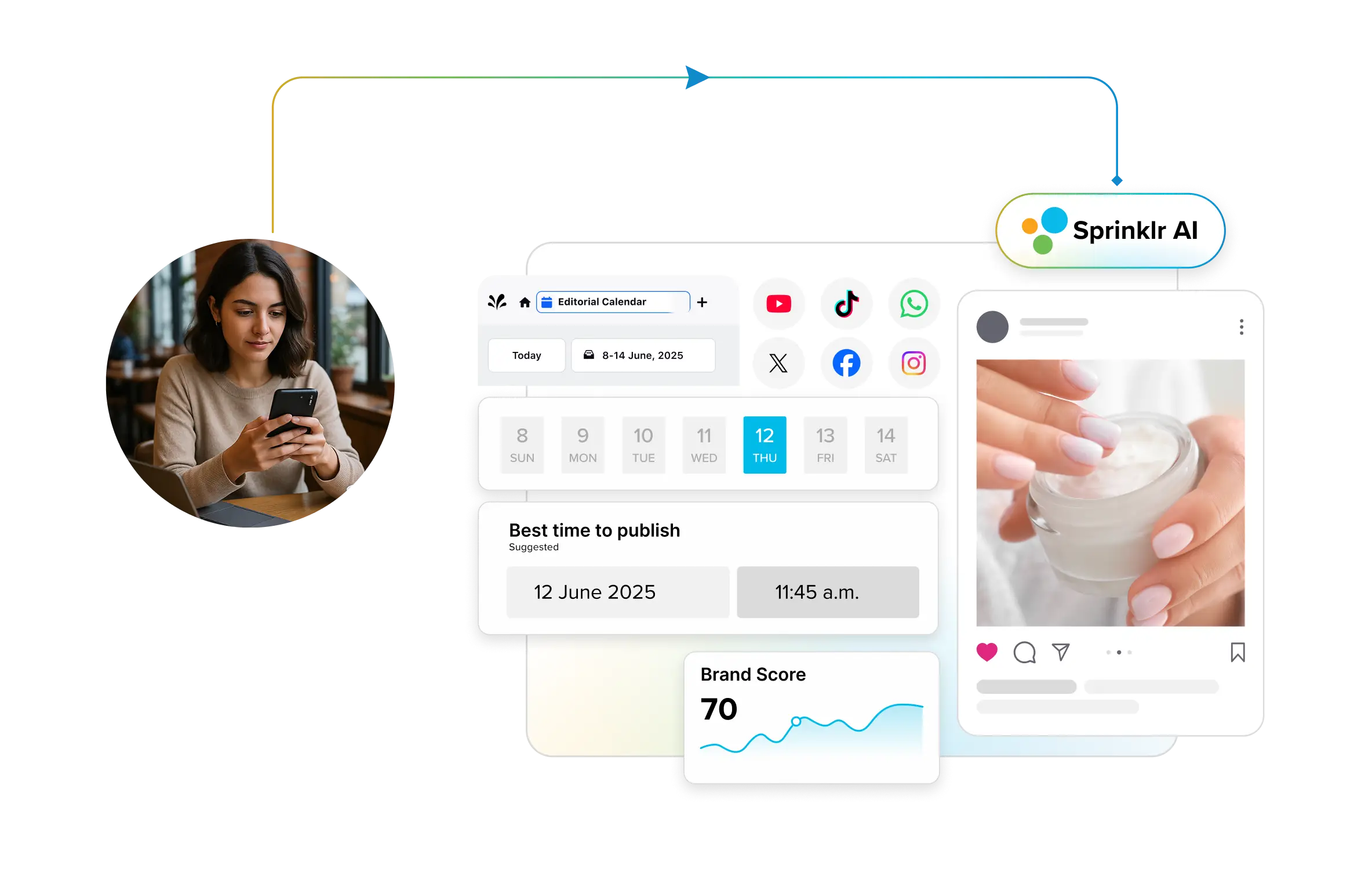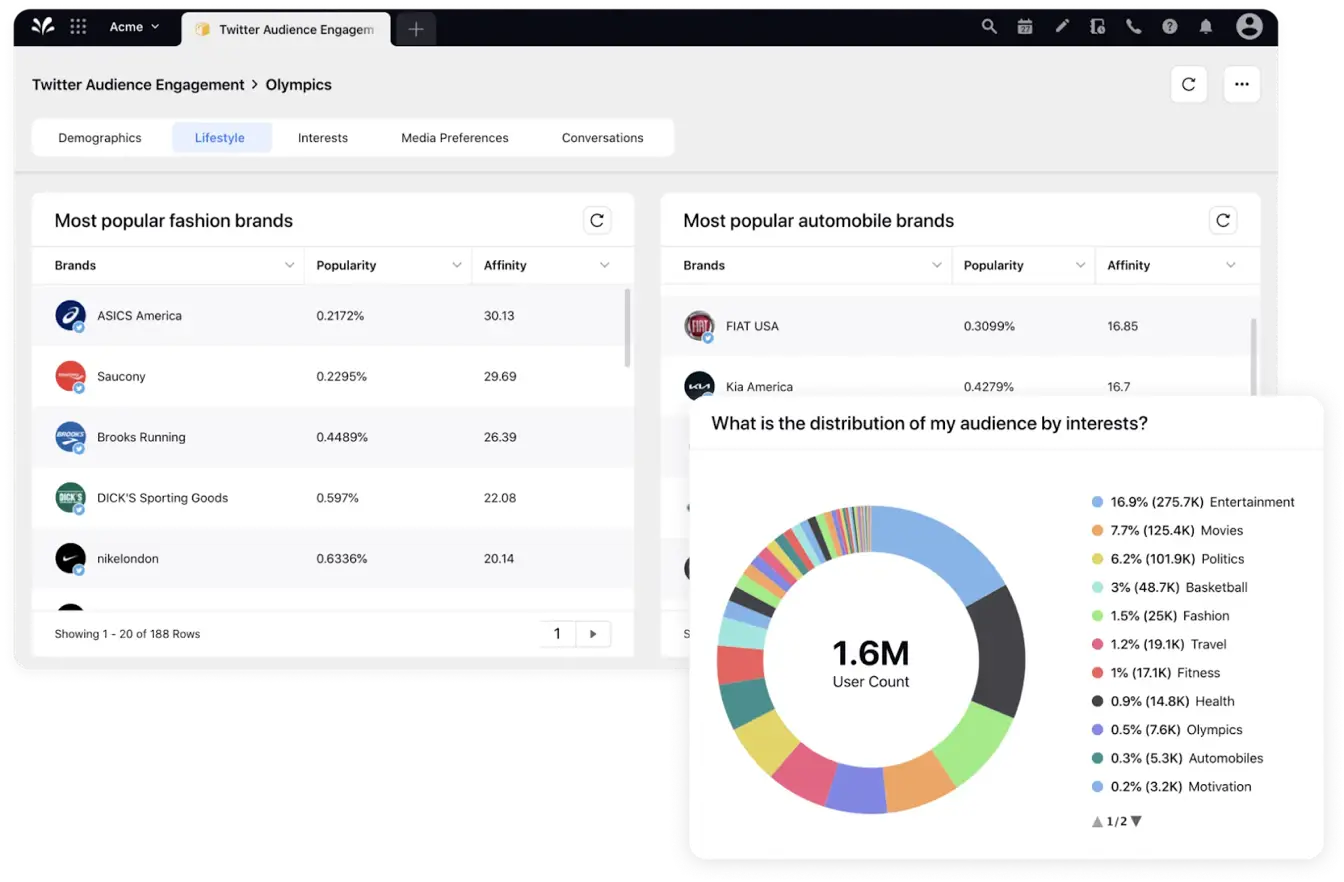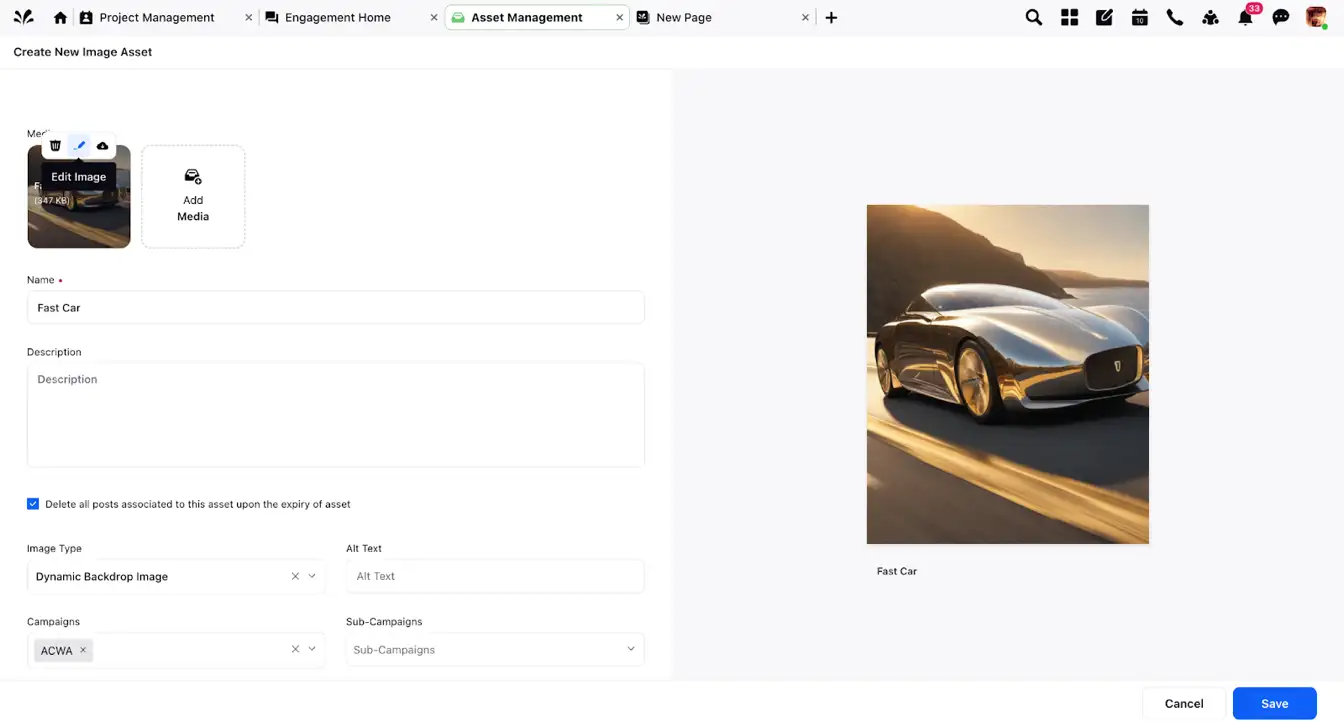The global leader in enterprise social media management
For over a decade, Sprinklr Social has helped the world’s biggest brands reimagine social media as a growth driver with a unified platform, industry-leading AI and enterprise-grade scale.

Automotive Social Media Marketing: 5 Critical Trends to Know
As social media platforms dominate global digital experiences, the automotive industry is finding itself at a pivotal moment—one where digital presence can make or break a brand. Automotive social media marketing influences how vehicle brands are perceived and how they reach their target audience.
With over 90% of consumers reporting that they consult social media when researching their next car purchase and 80% repurchase from brands offering tailored experiences, automotive brands cannot afford to ignore their online presence. For car manufacturers, this means more than just selling vehicles — it’s about building a loyal customer base through meaningful online interactions. The way consumers engage with brands online has transformed, and automotive companies must adapt to these shifts to remain competitive.
In this blog, we’ll explore five key trends, including the rise of micro-influencers, the impact of AI-driven personalized content, and the importance of sustainability messaging, all of which are driving the future of automotive marketing.
What is automotive social media marketing?
Automotive social media marketing refers to the strategic use of social media platforms like Facebook, Instagram, YouTube, Twitter (X), and TikTok to promote, advertise, and engage with customers around automotive products, services, and brands. It involves creating and sharing content—such as posts, videos, ads, and stories—that not only highlights a brand’s vehicles and offerings but also fosters direct interaction with consumers.
This approach goes beyond traditional advertising by building meaningful relationships, understanding customer preferences through social listening, and responding to real-time feedback. Automotive social media marketing allows brands to shape their narratives, influence public perception, and boost customer loyalty. It also offers valuable data insights that can inform marketing strategies, improve customer service, and drive sales.
Building an effective social media marketing strategy is vital for automotive brands to thrive in today’s customer-driven market, as it results in:
· Better engagement: Social media enables real-time interaction, allowing brands to address customer inquiries, provide updates and offer support instantly.
· Personalized marketing: Platforms allow automotive companies to deliver tailored messages, ensuring that content resonates with diverse audience segments.
· Highlighting innovation: Automotive brands can show innovative technologies, features, or sustainability efforts, aligning with the values of modern customers.
· Building trust and transparency: Social proof through user reviews, testimonials and influencer marketing strategies establishes trust and boosts confidence in the brand.
· Competitive edge: As most customers research products online before purchasing, a strong social media presence ensures brands remain top-of-mind in a highly competitive market.
Why is social media important for automotive companies?
Social media offers benefits that traditional advertising can't match. Let's explore how these advantages apply to the automotive sector:
1. Reducing marketing costs
Social media offers a relatively cost-effective way to reach targeted audiences compared to traditional advertising. A 30-second commercial ad on television can cost $100 to $1,500. On social media, the cost is as low as $1 per day for impressions or $15 to $200 per day for other types of ads. Further, it allows for targeted, cost-per-click ads that focus on specific customer segments. So, a video showcasing a new vehicle's features can reach millions at a fraction of the cost of a television commercial.
For example, Ford has shifted its focus to post-purchase marketing, leveraging digital platforms to engage with existing customers on services like warranties and accessories. By using social media and digital channels, Ford significantly reduces its marketing budget while still driving revenue through after-sales. In fact, the company reduced its global advertising spending from $3.1 billion in 2021 to $2.2 billion in 2022 while still generating $108.7 billion in revenue up from $87.8 billion in 2021.
2. Reaching new audiences
Social media platforms help automotive brands tap into new customer segments by targeting users based on their interests, demographics, and behaviors. For example, a luxury SUV brand could target high-net-worth individuals through tailored social media campaigns on Instagram, while an electric vehicle brand could focus on eco-conscious consumers on platforms like TikTok and Facebook.
Audi, for instance, launched its e-tron SUV using a creative social media strategy. This included live streaming the debut on Twitter and aligning with major events like the Super Bowl and the premiere of "Avengers: Endgame." The campaign generated 1.8 million Periscope live-stream video views and outperformed industry benchmarks, driving significant engagement and brand awareness.
3. Managing reputation and controlling PR crises
Social media is a double-edged sword; it can make or break a brand’s reputation. Proactive social listening allows companies to quickly identify and address potential PR crises. They can track social mentions, conversations and sentiments around their brand. Quick identification of potential issues allows for immediate action, preventing escalation.
Automotive social media marketing provides real-time monitoring, facilitates transparent communication and enables direct audience engagement. This allows businesses to quickly address potential PR crises and effectively maintain a positive brand reputation.
In 2023, Toyota faced a recall of over 1 million vehicles due to a potential issue with its airbag system. Toyota's robust social media strategy was central to managing the crisis. The company quickly used its platforms to communicate directly with customers, providing clear and transparent information about the recall, the affected models and the steps customers needed to take.
4. Launching new products
Social media is an ideal platform to generate pre-launch buzz and create excitement surrounding new vehicle releases. Teaser campaigns, behind-the-scenes content and live events on platforms like Instagram and Facebook can significantly amplify awareness and desirability.
Rivian, an American electric vehicle startup, effectively used social media to generate excitement around its all-electric R1T truck launch. The team shared user-generated content (UGC) and teasers about the brand’s new electric truck, engaging with its growing community of eco-conscious enthusiasts and potential buyers.
More to read 📚: Plan the perfect product launch for social media
5. Understanding customer sentiment and refining products
Social media provides valuable insights into customer sentiments. By monitoring online conversations, automotive companies can understand consumer preferences, identify areas for improvement, and refine products based on real-time customer feedback.
Lucid Motors, a luxury electric vehicle manufacturer, actively monitored social media feedback on its Lucid Air sedan. By tracking user sentiment across platforms like Twitter, Lucid was able to refine certain features based on early customer concerns, particularly around software updates.
Top social media trends for automotive companies
Social media trends for automotive companies are constantly evolving to meet changing consumer behaviors and technological advancements. Here are five key trends that marketers need to know while defining their automotive social media marketing strategy:
1. Customers prefer a connected experience
Automotive brands use social media to create seamless, interactive and connected experiences that enhance customer engagement and loyalty.
With more than 90% of vehicles sold in 2030 projected to be connected, companies like BMW are integrating social platforms for everything from virtual test drives to after-sales support.
BMW’s My BMW app integrates social feedback loops, service reminders and AR vehicle previews, fostering an ongoing digital relationship with customers.
Unlock the secret to seamless customer experiences! Watch our on-demand webinar and learn how unifying your Martech stack can boost efficiency, creativity, and customer satisfaction.
2. Live streaming and virtual events are on the rise
Did you know that 63% of car buyers in the UK are open to buying cars online? Brands can leverage this for live streaming events on social platforms.
Automotive companies use live streaming for product launches, question-and-answer sessions, and behind-the-scenes content.
For example, Tesla frequently live streams its product unveilings and CEO Elon Musk's talks, creating buzz and direct interaction with the audience.
3. Gamification to boost engagement
The global gamification market is expected to reach $14.5 billion in 2025. Automotive brands are using gamification to create meaningful and engaging experiences for their audience. By incorporating elements like quizzes, contests and rewards into their marketing strategies, companies can engage customers on a deeper level.
Porsche incorporates gamification into its marketing by offering exclusive driving experiences, including track days and driving challenges. Participants compete for rewards and recognition based on their on-track performance. This creates memorable interactions for its users and also strengthens brand loyalty by engaging customers in a fun and rewarding way.
4. AR/VR experiences revolutionizing car exploration
According to reports, the global AR market in the automotive market is expected to grow from $4.51 billion in 2021 to $14.44 billion in 2028. Augmented reality (AR) and virtual reality (VR) are transforming how consumers explore cars. These technologies enable customers to experience vehicles in immersive environments by virtually exploring features, customizing designs or taking simulated test drives.
For example, Audi’s "Virtual Showroom" lets users engage in a fully interactive 3D environment to explore car features. Through VR headsets, users can experience vehicle designs and features firsthand and even customize options without being physically present at the dealership.
Read more 📕: How 4 leading brands use AR and VR to create memorable customer experiences
5. Sustainability and EV messaging capture the attention
In 2023, nearly one in five cars sold globally was electric, signaling a significant shift toward sustainable mobility. As consumers become more eco-conscious, automotive brands are leveraging social media to promote their electric vehicles and sustainable initiatives, highlighting their commitment to reducing carbon footprints.
Automakers are focusing on sustainability by incorporating recycled materials into their EVs. For example, Hyundai uses renewable resources like corn and bamboo charcoal in its IONIQ 6 parts.
For more insights, check out global social media trends in 2025.
Tips to make effective automotive social media campaigns
While creating effective campaigns, brands require more than just posting content. Here are three tips to design a campaign that helps enhance your social media marketing automotive industry:
1. Data-driven targeting
Don’t rely on guesswork. Leverage advanced social media analytics tools to understand your target audience's preferences and behaviors. Then, use this data to tailor your campaigns for maximum impact.
In the fast-paced automotive market, understanding exactly how your audience engages with your content can make or break your campaign. Consider using an audience intelligence tool like Sprinklr to get granular insights and enhance your targeting strategy.
Sprinklr Insights can help in analyzing social signals, engagement metrics and audience profiles to understand what resonates with your followers.

2. Compelling visual storytelling
Visuals are crucial in the automotive industry. Invest in high-quality visuals to showcase your vehicles' features and performance, whether through photos, videos or immersive experiences like AR.
For high-quality visuals in automotive social media campaigns, it's crucial to create engaging and professional images that showcase your products in their best light.
By using AI tools for image creation and enhancement you can produce quality content and streamline your image creation and publishing process. This also enhances engagement and drives your social media performance.

Book a demo to explore how Sprinklr can optimize your visual content creation and editing process!
3. Real-time engagement and response
Don't just broadcast! Engage actively with your audience by monitoring social conversations, responding to comments and participating in relevant discussions in real time. To sort tracking & monitoring, Sprinklr’s social listening tool can help you monitor all conversations across social media channels in real-time for proactive engagement.
Final Thoughts
As the automotive industry continues to evolve in a digitally-driven world, automotive social media marketing is no longer just an option—it’s a necessity. From initial research to post-purchase engagement, the opportunities to influence consumer decisions are abundant across social platforms. But to fully capitalize on these opportunities, you need a unified strategy and platform that brings together social listening, content management, and data insights.
Sprinklr Social provides exactly that—a comprehensive, all-in-one solution that empowers automotive brands to engage with customers, optimize performance, and amplify their reach. Whether you’re looking to boost brand awareness, empower distributed teams, or drive sales through conversational commerce, Sprinklr gives you the tools to transform your social media strategy at scale.
With Sprinklr, you can:
- Deliver content and engage with your audience across multiple channels, building meaningful relationships.
- Empower your teams to generate leads and accelerate conversions with seamless collaboration.
- Amplify brand reach with employee advocacy, increasing visibility by up to 8x.
- Gain real-time insights from millions of data sources with social listening, competitive benchmarking, and AI-powered visual monitoring.
- Optimize ad campaigns across 30+ digital & social channels from a single dashboard to boost ROAS.
- Elevate customer service with AI-driven support on social platforms, increasing customer satisfaction.
To see how these features can elevate your marketing efforts, schedule a demo today.
Frequently Asked Questions
Dealerships can create localized social media content by targeting specific geographic areas, promoting local events, and highlighting regional vehicle inventory.
Automotive companies can use proactive social listening to address and mitigate potential PR crises. Using social listening tools can further enable the swift identification and response to negative sentiment or crises, minimizing reputational damage.
Create short, engaging videos and infographics that explain complex technologies that can be used to educate consumers about new automotive technologies.
Automotive brands can use social media to create personalized customer experiences throughout the car-buying journey by leveraging data insights to target different customer segments with tailored messaging.
User-generated content in automotive social media marketing provides social proof and builds community, easily monitored and curated.
Consumer insights allow automotive companies to identify and analyze consumer feedback, informing product development and improvement.










